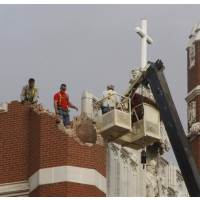U.S. Geological Survey Calls Oklahoma Quake the Largest “Human-Induced” Earthquake on Record
 Earthquake damage at St. Gregory's University in Shawnee, Oklahoma November 6, 2011 (photo: Sue Ogrocki, AP)
Earthquake damage at St. Gregory's University in Shawnee, Oklahoma November 6, 2011 (photo: Sue Ogrocki, AP)
A study by the U.S. Geological Survey (USGS) associates a 5.7-magnitude earthquake in Oklahoma—the most powerful in the state’s history—with the practice of injecting wastewater from fracking into the earth’s crust.
The quake occurred on November 6, 2011, near Prague, Oklahoma. USGS scientists say it may have happened as a result of a 5.0-magnitude foreshock that happened on November 5 near some wastewater injection wells. The 5.0 quake increased stress at the site of the next day’s 5.7 quake.
“The observation that a human-induced earthquake can trigger a cascade of earthquakes, including a larger one, has important implications for reducing the seismic risk from wastewater injection,” said USGS seismologist and co-author of the study Elizabeth Cochran.
In the process of hydraulic fracturing, or fracking, water and chemicals are pumped into the Earth to force out deposits of oil and gas. The waste chemicals are then injected back into disposal wells. This practice is what researchers believe caused the quakes. Moderate-sized earthquakes such as those in Oklahoma have been increasing in number in areas in the central United States near fracking sites.
“Even if wastewater injection only directly affects a low-hazard fault, those smaller events could trigger an event on a larger fault nearby,” Cochran told Live Science.
The USGS study isn’t the first to link earthquakes to wastewater disposal. In 2013, University of Oklahoma professor Katie Keranen found evidence linking the wells to an increase in seismic activity.
Other states have seen similar increases in earthquakes near injection sites. An area near an Ohio injection site experienced nine seismic events in eight months in 2011.
-Steve Straehley
To Learn More:
2011 Oklahoma Induced Earthquake May Have Triggered Larger Quake (U.S. Geological Survey)
Wastewater Injection Triggered Oklahoma's Earthquake Cascade (by Becky Oskin, Live Science)
Oklahoma's Largest Quake in Decades Buckles Highway; Rattles Residents (CNN)
Fracking Suspected in Rash of Earthquakes in Unlikely Places (by Noel Brinkerhoff and David Wallechinsky, AllGov)
Study Suggests Oklahoma Earthquakes Due to Oil Drilling Waste Disposal (by Noel Brinkerhoff, AllGov)
- Top Stories
- Unusual News
- Where is the Money Going?
- Controversies
- U.S. and the World
- Appointments and Resignations
- Latest News
- What If China Invaded the United States?
- Donald Trump Has a Mental Health Problem and It Has a Name
- Trump Goes on Renaming Frenzy
- Trump Deports JD Vance and His Wife
- Trump Offers to Return Alaska to Russia






Comments